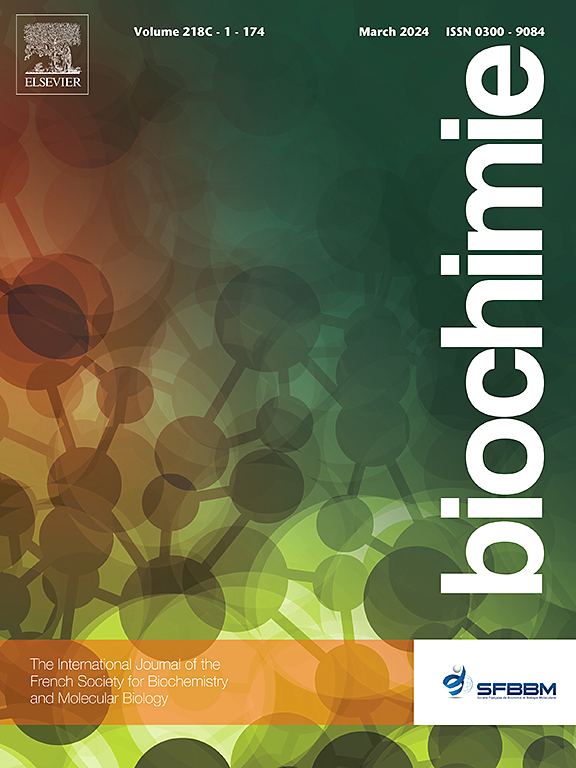Celastrol调节小鼠味蕾细胞中的钙信号和小鼠对膳食脂肪酸的味觉偏好。
IF 3
3区 生物学
Q2 BIOCHEMISTRY & MOLECULAR BIOLOGY
引用次数: 0
摘要
雷公藤红素是一种萜类化合物,已被证明对健康和疾病,特别是对肥胖,有几种有益的特性。近年来的研究表明,膳食脂肪酸的口感检测在肥胖的发病机制中起着重要的作用。在本报告中,我们研究了celastrol在Fluo-4/AM负载小鼠味蕾细胞(mTBC)中钙信号的调节和小鼠脂肪味觉感知中的作用。发现Celastrol诱导mTBC中游离细胞内钙浓度[Ca2+]i的增加。Celastrol似乎通过胆汁酸TGR5 (Takeda-G-protein-receptor-5)受体发挥作用。此外,磷脂酶C (PLC)抑制剂U-73122显著减少了celastrol诱导的钙信号,这表明该药物通过肌醇-三磷酸(IP3)的产生引发内质网钙信号的增加。celastrol从细胞内池中募集的Ca2+触发TRPC3通道的开放。我们进一步使用了已知可以触发[Ca2+]i增加的thapsigargin (TG)。Celastrol共享tg招募的Ca2+池。在这些细胞中观察到雷公藤红素共享亚油酸触发的Ca2+信号。在两瓶选择范式中,雷公藤红素增加了对亚油酸的味觉偏好。我们的研究可能有助于考虑合成雷公藤红素类似物作为脂肪味道调节剂,在肥胖的管理中具有潜力。本文章由计算机程序翻译,如有差异,请以英文原文为准。
Celastrol modulates calcium signaling in mouse taste bud cells and gustatory preference for a dietary fatty acid in the mouse
Celastrol, a terpenoid, has been shown to exert several beneficial properties in health and disease, particularly in obesity. Recent studies have demonstrated that orosensory detection of dietary fatty acids plays an important role in the pathogenesis of obesity. In the present report, we have studied the role of celastrol in the modulation of calcium signaling in Fluo-4/AM loaded mouse taste bud cells (mTBC) and fat taste perception in the mouse. Celastrol was found to induce increases in free intracellular calcium concentrations, [Ca2+]i, in mTBC. Celastrol seems to exert its action via bile acid TGR5 (Takeda-G-protein-receptor-5) receptor. Furthermore, U-73122, a phospholipase C (PLC) inhibitor, significantly curtailed celastrol-induced calcium signaling, suggesting that this agent triggers an increase from endoplasmic reticulum via inositol-tris-phosphate (IP3) production. Celastrol-recruited Ca2+ from intracellular pool that triggered the opening of TRPC3 channels. We further employed thapsigargin (TG), known to trigger an increase in [Ca2+]i. Celastrol shared the TG-recruited Ca2+ pool. Celastrol was observed to share linoleic acid-triggered Ca2+ signaling in these cells. In two-bottle choice paradigm, celastrol increased the gustatory preference for linoleic acid. Our study might be helpful for considering the synthesis of celastrol analogues as fat taste modifiers with a potential in the management of obesity.
求助全文
通过发布文献求助,成功后即可免费获取论文全文。
去求助
来源期刊

Biochimie
生物-生化与分子生物学
CiteScore
7.20
自引率
2.60%
发文量
219
审稿时长
40 days
期刊介绍:
Biochimie publishes original research articles, short communications, review articles, graphical reviews, mini-reviews, and hypotheses in the broad areas of biology, including biochemistry, enzymology, molecular and cell biology, metabolic regulation, genetics, immunology, microbiology, structural biology, genomics, proteomics, and molecular mechanisms of disease. Biochimie publishes exclusively in English.
Articles are subject to peer review, and must satisfy the requirements of originality, high scientific integrity and general interest to a broad range of readers. Submissions that are judged to be of sound scientific and technical quality but do not fully satisfy the requirements for publication in Biochimie may benefit from a transfer service to a more suitable journal within the same subject area.
 求助内容:
求助内容: 应助结果提醒方式:
应助结果提醒方式:


